A broken ankle can be a painful nuisance preventing you from doing the activities you enjoy. The fracture will heal according to the severity of the broken ankle. Some severe and complicated fractures may require surgery whilst other broken ankle injuries may only need immobilization and rest of the ankle joint. There are some tips to follow to speed up the healing process and also some prevention points to keep your ankles safe in the future.
Broken Ankle Recovery Time
Most ankle fractures can take between 4-8 weeks to heal depending upon the extent of the damage. It may take a further period of time to regain the full range of motion and use of that ankle. Any ligaments and tendons involved will also need time to recover. Complicated fractures that require surgery or placement of metal rods or screws will take even longer because those supports will have to be surgically removed.
A return to your previous competitive level will take several months. Usually most people can resume driving their car with 9-12 weeks depending on the type of fracture. Everyday tasks like shopping will have to be avoided and delegated to friends or family for the first few weeks of recovery.
During your recovery period, see you doctor if:
- The pain is not relieved by your painkillers or if the pain increases in intensity.
- You develop other health-related problems.
- You want to return to work earlier than was advised by your doctor.
- You want to travel by air. Your risk of deep vein thrombosis (DVT) increases after you’ve had surgery.
Get immediate medical attention if:
- There is bad-smelling discharge from your surgical wound.
- There is swelling around the ankle.
- The skin around the injury has turned blue.
- You experience pins and needles or numbness in your toes.
Broken Ankle Recovery Exercises
You may be referred to a physiotherapist after your fracture has been treated to learn how to use your crutches, cane or walker to prevent undue stress on the healing fracture. Even though your ankle is immobilized, you will have to keep up the muscle strength of your knee and hip so that they do not get too weak while recovering from the break. You will be encouraged to follow an exercise program at home to improve ankle strength and range of motion. Physical therapy will improve your mobility and help you get back to your normal activities. Some exercises may include:
1. Ankle Range of Motion
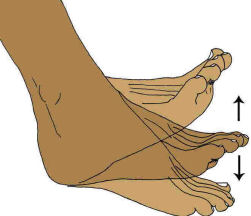
2. Towel Stretch
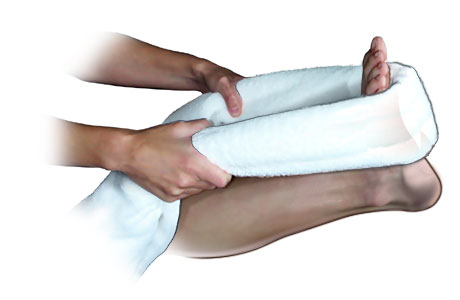 Sit on the floor with the injured foot stretched out before you. Place a towel around the ball of your foot; pull the towel gently towards your body without bending the knee. For better results in broken ankle recovery, this stretch should be repeated about 3 times; holding the stretch up to 30 seconds.
Sit on the floor with the injured foot stretched out before you. Place a towel around the ball of your foot; pull the towel gently towards your body without bending the knee. For better results in broken ankle recovery, this stretch should be repeated about 3 times; holding the stretch up to 30 seconds.
3. Plantar Reflexion with Resisted Ankle
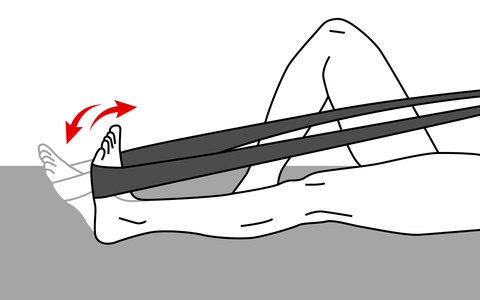 Sit on a hard surface with the injured leg outstretched before you. Loop around your ball of foot with a piece of elastic tubing, holding the ends of the tubing in each hand. Push the ball of the foot away from the body against the tubing. Go back to the start position. You can repeat the exercise doing 2 sets of 15 repetitions.
Sit on a hard surface with the injured leg outstretched before you. Loop around your ball of foot with a piece of elastic tubing, holding the ends of the tubing in each hand. Push the ball of the foot away from the body against the tubing. Go back to the start position. You can repeat the exercise doing 2 sets of 15 repetitions.
4. Standing Calf Stretch
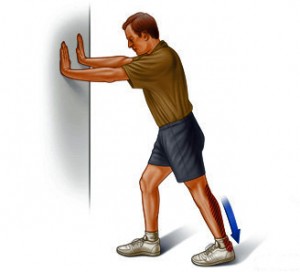 Stand up and face a wall with your hands braced on the wall at eye level. Hold injured foot back, toes facing slightly inward. Your other leg should be forward with the knee bent. Lean onto the wall until you feel a stretch in your back injured calf. Go back to the beginning position. Do this stretch a few times per day; holding the stretch for up to 30 seconds at a time.
Stand up and face a wall with your hands braced on the wall at eye level. Hold injured foot back, toes facing slightly inward. Your other leg should be forward with the knee bent. Lean onto the wall until you feel a stretch in your back injured calf. Go back to the beginning position. Do this stretch a few times per day; holding the stretch for up to 30 seconds at a time.
Once you can stand on the injured ankle without pain, you can do the following:
5. Step-ups
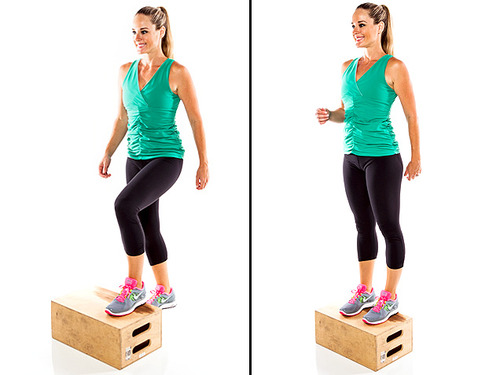 Rest your injured foot on a small wooden block or step (8-13cm high) with the other foot flat on the ground. Move your weight to the injured foot on the step. Straighten the injured leg while the other foot leaves the ground. Bend the injured leg to return the other foot to the ground-back to starting position. Repeat for 2 sets of 15 repetitions.
Rest your injured foot on a small wooden block or step (8-13cm high) with the other foot flat on the ground. Move your weight to the injured foot on the step. Straighten the injured leg while the other foot leaves the ground. Bend the injured leg to return the other foot to the ground-back to starting position. Repeat for 2 sets of 15 repetitions.
6. Heel Raises
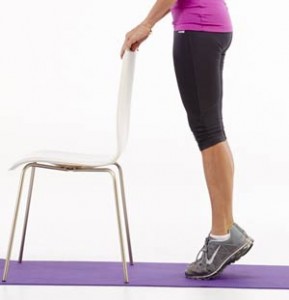 Stand on a flat surface after a chair for support with both feet flat on the ground. Raise yourself and hold for a few seconds. Lower your body-try not to use the support of the chair. When you become stronger, you can stand only on the injured leg for raising and lowering. Repeat for 2 sets of 15 with an interval of 30 seconds to rest.
Stand on a flat surface after a chair for support with both feet flat on the ground. Raise yourself and hold for a few seconds. Lower your body-try not to use the support of the chair. When you become stronger, you can stand only on the injured leg for raising and lowering. Repeat for 2 sets of 15 with an interval of 30 seconds to rest.
More Tips to Speed up Broken Ankle Recovery
- Do not try to bear weight on the injured ankle before the timescale your doctor has advised. Bearing weight on the injured foot before the ankle is ready can result in further injury and prevent a speedy recovery.
- Use the mobility devices prescribed to ensure your weight is off the injured foot.
- If you have had surgery, follow a healthy diet and nutritional supplementation to optimize bone healing.
- Control your blood sugar levels if you have diabetes because uncontrolled glucose levels will delay bone healing.
- Stop smoking as it affects wound and bone healing as well.
Although most accidents are difficult to predict you can take some precautions to prevent an ankle injury:
- Wear proper footwear appropriate to the activity being performed.
- Proper support will prevent further injury like wearing a brace or tape.
- Keeping the muscles around the ankle joint strong to stabilize the bones.
